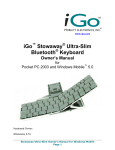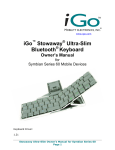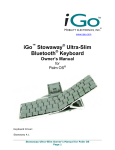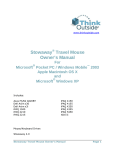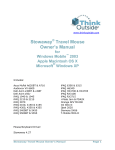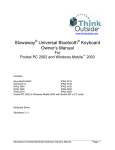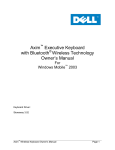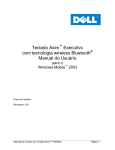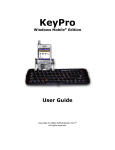Download Mobility Electronics Stowaway Stowaway Bluetooth Keyboard Owner`s manual
Transcript
www.igo.com iGo™ Stowaway® Bluetooth® Mouse Owner’s Manual for Pocket PC 2003/Windows Mobile™ 5 Apple Macintosh OS X Microsoft® Windows XP Mouse/Keyboard Driver: Stowaway 4.51 Stowaway Bluetooth Mouse Owner’s Manual Page 1 Installing the Mouse with Macintosh OS X....................3 Before You Begin....................................................................................3 Creating a Paired Connection with your Macintosh ............................3 Installing the Mouse for Use with Windows XP ............4 Before You Begin....................................................................................4 Creating a Paired Connection with your PC.........................................4 Setting up the Mouse with Pocket PC ...........................5 Before You Begin....................................................................................5 Installing the Software............................................................................5 Configuring the Mouse to Your Device .........................6 Reconnecting the Stowaway Mouse............................12 Bluetooth Accessibility ........................................................................13 Customizing Mouse Functions.....................................14 Input Method Toolbar ...........................................................................14 Mouse Control Panel ............................................................................15 Disabling the Stowaway Mouse...........................................................16 Mouse Discoverable Mode ...................................................................16 Device Pairing Overview ......................................................................16 Using the Stowaway Mouse..........................................17 Moving the Pointer/Highlighting Text .................................................17 On-Screen Buttons and Application Launching ................................17 Menu and Toolbar Navigation..............................................................18 Frequently Asked Questions ........................................19 Legal Notices..................................................................21 Trademarks............................................................................................21 Warranty ................................................................................................22 Important Battery Information .............................................................24 Important notes about Bluetooth devices ..........................................25 Regulatory Notices ...............................................................................25 Features and Specifications Summary........................32 Stowaway Bluetooth Mouse Owner’s Manual Page 2 Installing the Mouse with Macintosh OS X Before You Begin ¾ Determine that your Macintosh is Bluetooth-enabled with either a built-in Bluetooth component, or via an external hardware adaptor (Dongle). ¾ Ensure that the accompanying Bluetooth software (Stack) is installed. ¾ It is not necessary to disable or remove your existing mouse software. (Refer to the User’s Guide included with your Macintosh with any questions on your current mouse.) ¾ Insert the 2 AAA batteries (included) beneath the battery cover of the Stowaway Mouse. Creating a Paired Connection with your Macintosh 1. Install the Bluetooth Dongle, if necessary, and launch the accompanying Bluetooth Setup Assistant on your Macintosh. 2. Refer to the instructions included with the Bluetooth Setup Assistant on the process for Pairing Devices. 3. Power on the Stowaway Mouse by switching the Power switch to ON and press the Discoverable button to make it detectable by the Bluetooth software on your Macintosh. 4. Begin device detection for the mouse with the Bluetooth Setup Assistant, and locate the Stowaway Mouse among any found devices. 5. Select the Bluetooth mouse in the list of discovered devices to create a link to your Macintosh. 6. After the mouse is successfully linked with your Macintosh, the mouse pointer will immediately begin responding to movement and button presses, similar to your standard mouse. Refer to the User Guide for your Macintosh to modify mouse functionality within the Macintosh Operating System. Stowaway Bluetooth Mouse Owner’s Manual Page 3 Installing the Mouse for Use with Windows XP Before You Begin ¾ Determine that your PC is Bluetooth-enabled with either a built-in Bluetooth component, or via an external hardware adaptor (Dongle). ¾ Ensure that the accompanying Bluetooth software (Stack) is installed. ¾ It is not necessary to disable or remove your existing mouse software. (Refer to the User’s Guide included with your PC with any questions on your current mouse.) ¾ Insert the 2 AAA batteries (included) beneath the battery cover of the Stowaway Bluetooth mouse. Creating a Paired Connection with your PC 1. Install the Bluetooth Dongle, if necessary, and launch the accompanying Bluetooth software on your PC. 2. Refer to the instructions included with your Bluetooth software on the process for Pairing Devices. 3. Power on the Stowaway Mouse by switching the Power switch to ON and press the Discoverable button to make it detectable by the Bluetooth software on your PC. 4. Begin device detection, and locate the Stowaway Mouse among any found devices. 5. Establish a link between the computer and the Stowaway Mouse. (Refer to the User Guide included with your Bluetooth software for instructions on how to do this.) 6. After the mouse is successfully linked with your PC, the mouse pointer will immediately begin responding to movement and button presses, similar to your standard mouse. Refer to the User Guide for your PC on the Windows Control Panel Mouse applet to modify mouse functionality within Windows. NOTE: The remainder of this document primarily addresses the Stowaway Mouse for use with Pocket PC / Windows Mobile2003-enabled PDAs. Stowaway Bluetooth Mouse Owner’s Manual Page 4 Setting up the Mouse with Pocket PC Before You Begin Before you install the Stowaway keyboard and mouse software for Pocket PC 2003/Windows Mobile 5.0 PDAs: ¾ ActiveSync 4.0 or greater is required to install the keyboard driver application. ¾ Disable or uninstall any other keyboard or mouse applications that you have previously installed on your mobile device. ¾ Ensure there is at least 250 KB of memory on your mobile device. To check the available memory, tap Start¼Settings¼System¼Memory. ¾ Insert the 2 AAA batteries (included) beneath the battery cover of the Stowaway Mouse and switch to ON. Installing the Software 1. Connect your mobile device to a computer using the docking cradle or sync cable. 2. Establish a connection between the computer and your mobile device using ActiveSync® 4.0 or later. 3. Insert the Stowaway CD-ROM into the CD-ROM drive on your PC. 4. Double-click the product, OS and language preferred to start the installation process. Follow the on-screen instructions to successfully install the software. NOTE: The driver must be installed in Main Memory on your device (default location) to function properly. 5. When prompted to reset your device, tap the on-screen OK button to complete the installation. 6. After the driver is successfully installed and the mobile device is reset, the keyboard driver and mouse icons will appear in the Programs window. NOTE: The Bluetooth connection between the mobile device and mouse must be set up through the Stowaway keyboard/mouse driver. Stowaway Bluetooth Mouse Owner’s Manual Page 5 Configuring the Mouse to Your Device 1. After the driver installation completes, the Stowaway Settings screen will display and you will be prompted to Choose device to setup. Select the Stowaway Bluetooth Mouse and tap Setup. 2. The Select mouse pointer mode screen will display for selecting Enhanced or Safe pointer mode: a. Enhanced mode – Works for most PDAs. Try Enhanced mode first. b. Safe mode – In the event that display issues arise with Enhanced mode, select Safe mode. It works for all PDAs, but may leave pointer traces on display. 3. Select Yes at the next screen to reset the PDA and apply the pointer mode. Stowaway Bluetooth Mouse Owner’s Manual Page 6 4. Once the PDA resets, the Confirm mouse pointer mode screen will display. If the PDA display is working properly, accept Enhanced mode by selecting Enhanced again, and tapping OK. Otherwise, select Safe and tap OK. 5. On Pocket PC devices with Windows Mobile 5.0 you may see a screen warning that the Stowaway Mouse driver will not work with the built-in Bluetooth Keyboard driver. You must tap Disable built-in HID driver in order for the mouse to work correctly. 6. The Bluetooth mouse status screen will open, stating that Connection is not set up. You may also open this page by selecting the Connection tab of the Stowaway Mouse application. You can begin a connection to the mouse and view the status of a connection from this screen. Make sure the mouse is Discoverable. To do this, press the Discoverable button on the underside of the mouse (Please refer to your Getting Started Guide for detailed instruction). NOTE: After the initial installation, the Mouse settings screen is opened automatically. Stowaway Bluetooth Mouse Owner’s Manual Page 7 7. Then tap the Connect button on the screen. The status will read Scanning for a mouse. 8. The status will change to Initializing connection. During the initialization stage, the application starts the Pocket PC Bluetooth system software, known as the Bluetooth Stack. 9. Once a mouse is detected, the application will begin Verifying connection by prompting you to move the mouse and click in the red box provided. This will verify that the correct mouse is being connected to your PDA. If you cannot use the mouse to click in the red box, tap Disable with the stylus and begin the connection again. Stowaway Bluetooth Mouse Owner’s Manual Page 8 10. If the connection process is successful, the Mouse connection enabled message will display on the Pocket PC device. This is the normal mode for wireless communication between the Stowaway Mouse and the Pocket PC device during use. 11. In the event that several Stowaway Bluetooth mice (or BT keyboards) happen to be nearby and in Discoverable mode, the scan will display all of these devices in the list. Compare the ID (Bluetooth address) of the device you’re using and select it from the list. 12. If the Bluetooth scan or connection fails, ensure the mouse is Discoverable and tap Connect again. If the connection still fails: a. Power cycle the mouse (turn off and on), make it Discoverable, and tap Connect. b. Or, reset the PDA, make the mouse discoverable, and tap Connect. c. If neither step works, check/replace the mouse batteries, and/or charge the PDA battery. Stowaway Bluetooth Mouse Owner’s Manual Page 9 13. If the mouse has previously been connected with your Pocket PC but you have pressed the Discoverable mode button during normal use, the mouse will lose its bond with your handheld device. Tap Connect to reestablish the bond. 14. On the Advanced page, there are buttons provided to select Power efficient mode and Mouse Pointer mode. a. Power efficient mode – Allows you to enable the Stowaway Mouse application to Auto-detect the proper power setting for your device combination (keyboard/mouse/PDA, etc.), or to turn On or Off Power efficient mode. b. Mouse pointer mode – Most PDA displays work well with Enhanced mode. Some will require Safe mode for effective mouse pointer tracking and use. 15. The Mouse Status Page displays the mouse battery status. The three states of the battery are Normal, Low and Critical: a. Normal – This is the most common state of the battery. b. Low – This is a warning that the batteries have reached a threshold where they should be replaced soon. c. Critical – This means the batteries are in imminent danger of reaching a point where they will no longer function. Stowaway Bluetooth Mouse Owner’s Manual Page 10 15. 16. When the mouse batteries reach Low or Critical, a warning message will also be displayed on the Today screen. If the mouse driver fails to detect a supported Bluetooth stack during the initial setup or at a later time (e.g. after power on), it will display the Bluetooth system not detected message on the Connection page. This should not happen on Pocket PC devices with a built-in Widcomm stack version 1.4.x or later or Microsoft stack, since it is always present and is supported by the mouse software. However, if the device has an incompatible version of the stack, this message may be displayed or the software may function improperly. In this case the mouse software must be replaced with an updated version. Stowaway Bluetooth Mouse Owner’s Manual Page 11 Reconnecting the Stowaway Mouse Despite a high degree of reliability, the Bluetooth connection could break for many reasons: ¾ When the mouse is powered off, the mouse circuit will be powered off, and the Bluetooth connection will be lost. ¾ As a power saving feature, the mouse will be automatically powered down after an idle period (when there is no activity for approximately 5 minutes). ¾ When the Pocket PC device is turned off, the established Bluetooth connection will be lost. ¾ When the Pocket PC device and the mouse are moved away from each other beyond the wireless range (~10m), the previously established connection is lost. When any of these conditions occurs, the connection will be lost and the software will switch to waiting mode. To restore the connection, make sure the mouse and Pocket PC device are powered on and in range, then press a mouse button. See Bluetooth Accessibility for further details. The connection should be reestablished within 2-3 seconds but this may be delayed if the Bluetooth system on the Pocket PC device is busy. For example, after the Pocket PC device is powered on, it may take 10 or more seconds for the Bluetooth system to re-initialize. NOTE: Do not press the Discoverable button. This will break the bond between the keyboard and the Pocket PC device. If this happens, you will have to establish a new connection as described above. Even when disconnected, the Pocket PC device and the mouse remain bonded. The mouse will only reconnect to the bonded Pocket PC device and the Pocket PC device will only listen to the bonded mouse. To break the bond, press the Discoverable button. Normally the bond will not need to be broken unless the mouse will be used with another Pocket PC device or another mouse will be used with the Pocket PC device. Therefore, please avoid pressing the Discoverable button during normal operation. If this has happened, you will have to establish a new connection as described in the Configuring the Mouse to Your Device section above. Stowaway Bluetooth Mouse Owner’s Manual Page 12 Bluetooth Accessibility For those using Windows Mobile 2003 or a non-Microsoft Bluetooth stack, there are two Bluetooth settings that affect how the mouse and the mobile device connect. If your Stowaway Mouse software returns to waiting mode, and pressing a mouse button will not trigger reconnection with the PDA, this may be because the Bluetooth stack is awaiting a signal only from a previously paired device, (such as if you had been using a Secured keyboard connection). If you want the convenience of not placing the mouse in Discoverable mode before every use, you will need to select All devices in the Bluetooth Settings applet. This will permit your Pocket PC to receive Bluetooth signals from unpaired devices, like the mouse. NOTE: Your Bluetooth screen may vary. Each manufacturer’s Bluetooth configuration screens differ, but generally you will find the All devices and Paired devices only options within the Bluetooth Settings under the Accessibility tab. This set of screens may be available directly via a Bluetooth icon on the Today screen, or from the Start MenuÖSettingsÖConnections tab. Stowaway Bluetooth Mouse Owner’s Manual Page 13 Customizing Mouse Functions Once the mouse software is installed on the Pocket PC device, you may customize the options. A mouse icon will display in the lower right corner of the screen while using Calendar, Contacts, or other applications. ¾ Tap the mouse icon on the bottom toolbar to display the Mouse Control Panel. ¾ Tap the keyboard icon at the Mouse Control Panel to display the Input Method Toolbar. Input Method Toolbar There are four icons that appear on the Input Method Toolbar. This assumes that the Stowaway Keyboard input method is selected from the Input Methods menu (tap the up arrow to the right of the keyboard icon in the lower right corner of the display). The leftmost icon shows the state of the Stowaway Mouse connection; there are three different states that can be indicated. A tap and hold on this icon will display a text message describing the state. ¾ This shows that the mouse connection is enabled. ¾ This shows that the connection is disabled or is waiting to reconnect. ¾ This shows that the connection failed or no mice were found. The other three icons relate to other features of the keyboard/mouse driver. ¾ Tap this speaker icon to turn the keyboard clicking sounds on or off (for use, if a Stowaway keyboard is installed). ¾ Tap this keyboard icon to access the Keyboard Control Panel. This second keyboard icon appears above the keyboard icon that is visible in the lower right corner of the screen. ¾ Tap this help icon to access keyboard and mouse help topics and troubleshooting tips. Stowaway Bluetooth Mouse Owner’s Manual Page 14 Mouse Control Panel On the Mouse tab: ¾ Tap Enable to choose which device to enable (the next screen will allow you to select the Stowaway Mouse). Tap Disable to turn off access to the mouse. ¾ To select Button Assignments for custom applications to launch, or functions to perform with each of the mouse buttons, tap the downarrows following the Left, Middle and/or Right drop down lists. ¾ To increase mouse pointer speed, drag the Mouse Speed slider to the right. ¾ To decrease key repeat speed, drag the Mouse Speed slider to the left. ¾ To select whether or not the mouse icon will appear in the lower right corner of the Today screen, check or uncheck the Show Icon on Today screen option. On the Connection tab: The Bluetooth mouse status screen lists the mouse status, firmware version and mouse battery status. There are three buttons available from this screen: ¾ To start a Stowaway Mouse connection, tap Connect. ¾ To disable an existing connection, tap or mouse click on Disable. ¾ To set Power efficient mode and Mouse pointer mode, tap or click on Advanced. This will open another screen where you can choose from Auto, On, or Off Power efficient mode, and Enhanced or Safe Mouse pointer mode. Help on these options is also available from the Advanced screen. On the About tab: ¾ The About tab indicates the keyboard/mouse software version installed on your Pocket PC device. Stowaway Bluetooth Mouse Owner’s Manual Page 15 Disabling the Stowaway Mouse When the Stowaway Mouse is no longer needed, you can disable it by tapping the Disable button, on the Connection or Mouse page. The Connection is not set up message will then be displayed on the Connection page. NOTE: Disabling the Stowaway Mouse will not automatically turn off the Bluetooth radio. Conversely, turning the Bluetooth radio off while the Stowaway BT keyboard driver is still enabled will not work. Because of the behavior of the Bluetooth stack, the Bluetooth radio will automatically turn back on after a few seconds. To re-enable the connection, tap the Connect button on the Connection page or tap Enable on the Mouse page. See Configuring the Mouse to Your Device for complete instructions. Mouse Discoverable Mode Discoverable mode is the state that allows the mouse to be detected by the Pocket PC device. ¾ To place the mouse in Discoverable mode, press the Discoverable button underneath the mouse. A green LED will light underneath the mouse to indicate it is Discoverable. Device Pairing Overview The Pocket PC and the Stowaway Mouse share a virtual cable. This means there is a 1:1 relationship between the Pocket PC device and the mouse. During connection, the Pocket PC device searches the Bluetooth radio band until it finds the mouse. Once completed, each time the Pocket PC device and mouse are powered on within range of each other, the devices will be reconnected with a simple mouse click. Once connected, the mouse leaves Discoverable mode, and will not be detected by other devices. The Pocket PC device on the other hand will retain the ability to create new pairings with other devices, such as a Bluetooth keyboard. Stowaway Bluetooth Mouse Owner’s Manual Page 16 Using the Stowaway Mouse Moving the Pointer/Highlighting Text Using default mouse functions: Mouse movements and Mouse button clicks, you can easily navigate, position the cursor, and select text for subsequent editing functions. You may also customize mouse functionality with the Left, Middle and Right Button Assignment options via the Mouse tab: To Perform/Navigate Mouse Click Launch Mouse Settings Context Menu Place text insertion point in text Select (highlight) Current Word Select (highlight) Current Paragraph Select (highlight) any amount of text Edit Text via Context Menu Scroll Up, Down, Left, or Right Press Left mouse button (default) Middle mouse button (default) Right mouse button (default) Single Mouse Click Double Mouse Click Triple Mouse Click Mouse Click, drag and release Right Mouse Click, Mouse Click option Customize a button on Mouse tab On-Screen Buttons and Application Launching By customizing mouse button activities in the Stowaway Mouse application, you can activate on-screen buttons such as (OK) or (X) and launch applications using the Left, Middle or Right mouse buttons. Note: Retain one mouse button for the Mouse Click, and customize the remaining two buttons via the Mouse tab. Following are a few of the tasks you can customize to mouse buttons: On-Screen Button and Application Launching OK/Close Window or Application Open Start Menu Launch Today Screen Toggle Input Method Toolbar On/Off Launch Mouse Settings Launch Keyboard Settings Launch Calendar Launch Contacts Launch Inbox Launch Tasks Launch Notes Launch Word Launch Excel Launch Internet Explorer Choose Data File (opens any file you choose) Stowaway Bluetooth Mouse Owner’s Manual Page 17 Menu and Toolbar Navigation You can access program menus, submenus, and toolbars with the Stowaway Mouse using the following activities. Action To activate a program’s menu bar at the bottom of the Pocket PC device screen and select a main menu item: • Mouse click on the menu title, then move the mouse and click on the menu item, or submenu you want to activate. To access a program’s toolbar at the top or bottom of the Pocket PC device screen: • Mouse click on the desired tool on the toolbar. Stowaway Bluetooth Mouse Owner’s Manual Page 18 Frequently Asked Questions Q: My mouse and handheld are in-range and powered on, why won’t they reconnect after a mouse button press? If Bluetooth Accessibility is set to Paired devices only, the mouse may not automatically reconnect. To allow the mouse to reconnect with a button press, change the default settings within the Bluetooth accessibility settings, see Bluetooth Accessibility. Q: What should I do when I try to use the mouse and nothing happens? • • • • • • Verify that the Pocket PC has an adequate battery charge. Verify that the Stowaway Mouse batteries do not need replaced. Check to make sure that the keyboard/mouse software is installed properly according to the instructions. Check the Connection tab of the Mouse Control Panel to make sure the Stowaway Bluetooth Mouse is enabled. Check the Mouse tab of the Mouse Control Panel to make sure you’ve selected the appropriate device type. After tapping Enable, you should select Stowaway Bluetooth Mouse. Use the Mouse Help icon to launch the help. Q: I tried to turn off the Bluetooth radio and it automatically turned back on, what should I do? The Stowaway Mouse must be disabled before the Bluetooth radio can be turned off. See the Disabling the Stowaway Mouse section for more information. Q: What is the Keyboard Control Panel for? If you ever install a Bluetooth wireless keyboard, Connected serial keyboard or Infrared wireless keyboard via the Config tab of the Keyboard Control Panel, you will see a BT, Serial and/or IR tab added to the Keyboard Control Panel and corresponding icons added to the Input Method Toolbar. Even if you disable the keyboard(s) and only use the Stowaway Bluetooth Mouse, the BT, Serial and/or IR tab and icons will remain. If you do not plan to need these options, you may choose to reinstall the driver and not enable them again so they will not display. Stowaway Bluetooth Mouse Owner’s Manual Page 19 Q: I received an error message saying the keyboard/mouse driver cannot find a supported Bluetooth component, what should I do? The current version of the keyboard/mouse driver supports Widcomm Bluetooth for Windows CE (BTW-CE) version 1.4.1 or later, and Microsoft stack version TBD. If you have a different version, you may need to check for upgrades for either the Bluetooth stack or for the mouse driver. (To determine the version of the Bluetooth stack installed on your Pocket PC device, locate the Bluetooth icon and tap it with the stylus to open the application. Find the Bluetooth About tab and tap to open the associated page. There you will find the version and build for the installed Bluetooth stack.) Should the mouse driver find more than one Bluetooth component on your Pocket PC device (for example if you have Bluetooth built-in and a removable Bluetooth card), then a dialog box will be displayed with a choice of available components. You will need to choose the Bluetooth component that you wish to be used with the Bluetooth mouse and tap OK. NOTE: Some Bluetooth components may not work with the mouse. If you are not able to connect to the mouse, you may have to return to the Mouse page, tap Enable again, select Stowaway Bluetooth Mouse, tap Setup, and then select another Bluetooth component. Q: My mouse was connected and input to Pocket PC device worked fine, but after a certain idle period, it seems that the connection was lost. Refer to the Reconnecting the Stowaway Mouse section. Q: How do I uninstall the keyboard and mouse driver? Select Start Ö Settings Ö System Tab Ö Remove Programs. Select Stowaway Keyboard and Mouse Driver from the list of applications then tap the Remove button. Stowaway Bluetooth Mouse Owner’s Manual Page 20 Legal Notices Mobility California, Inc. and its affiliates shall not be liable for technical or editorial errors or omissions contained herein or for special, indirect, incidental or consequential damages whatsoever in connection with the furnishing, performance, or use of this material. The information in this document is provided “as is” without express or implied warranty of any kind, including, but not limited to, the implied warranties of merchantability and fitness for a particular purpose, and is subject to change without notice. The warranties for Mobility California products are set forth in the express limited warranty statements accompanying such products. Nothing herein should be construed as constituting an additional warranty. Mobility California assumes no responsibility for any loss or claims by third parties, which may arise through the use of this software. Mobility California does not warrant that the software will be error-free, nor that the software will run uninterrupted. Mobility California assumes no responsibility for any damage or loss caused by deletion of data as a result of malfunction, dead battery, or repairs. Be sure to make backup copies of all important data on other media to protect against data loss. Information in this document is subject to change without notice. ©2006 Mobility California, Inc. All rights reserved. Reproduction of this document in any manner whatsoever without the written permission of Mobility California, Inc. is strictly forbidden. Trademarks Think Outside and Stowaway are registered trademarks of Mobility California, Inc. Broadcom is a registered trademark of Broadcom Corporation. Bluetooth and the Bluetooth logos are trademarks owned by Bluetooth SIG, Inc., U.S.A. and licensed to Broadcom Corporation. ActiveSync, Windows Mobile, Windows and Outlook are registered trademarks of Microsoft Corporation. Other trademarks and trade names may used in this document to refer to either the entities claiming the marks and names or their products. No proprietary interest in other trademarks and trade names is claimed. Stowaway Bluetooth Mouse Owner’s Manual Page 21 Warranty Mobility California warrants this product against defects in materials and workmanship under normal use for a period of one (1) year from the date of original retail purchase. Mobility California’s and its suppliers’ entire liability, and your exclusive remedy, if you discover a defect and return the product with proof of purchase to Mobility California during the warranty period, is that Mobility California will, at its option, repair, replace, or refund the purchase price of the product to you at no charge. This limited warranty is void if the defect results from accident, alteration, abuse, improper use, or exposure to water or extreme temperature. TO THE MAXIMUM EXTENT PERMITTED BY LAW, THIS LIMITED WARRANTY IS EXCLUSIVE AND MOBILITY CALIFORNIA DISCLAIMS ALL OTHER WARRANTIES, EXPRESS OR IMPLIED, INCLUDING WARRANTIES OF MERCHANTABILITY, FITNESS FOR A PARTICULAR PURPOSE, TITLE AND NON-INFRINGEMENT. MOBILITY CALIFORNIA IS NOT RESPONSIBLE FOR SPECIAL, INCIDENTAL, INDIRECT OR CONSEQUENTIAL DAMAGES (INCLUDING WITHOUT LIMITATION, DAMAGES FOR LOST PROFITS, LOST SAVINGS, OR OTHER DAMAGES) ARISING OUT OF THE USE OR INABILITY TO USE THE PRODUCT OR THE BREACH OF ANY EXPRESS OR IMPLIED WARRANTY, EVEN IF MOBILITY CALIFORNIA HAS BEEN ADVISED OF THE POSSIBILITY OF THOSE DAMAGES. Because some jurisdictions do not permit the exclusion or limitations set forth above, they may not apply in all cases. This warranty is governed by the laws of the State of California. Stowaway Bluetooth Mouse Owner’s Manual Page 22 Obtaining Warranty Service Customer must contact Mobility California within the applicable warranty period to obtain warranty service authorization. Dated proof of original purchase will be required for warranty service, repair, or replacement. Products or parts shipped by Customer to Mobility California must be sent postage-paid and packaged appropriately for safe shipment. Mobility California is not responsible for Customer products received without a warranty service authorization and may be rejected. Repaired or replacement products will be shipped to Customer at Mobility California’s expense. All products or parts that are replaced become the property of Mobility California. The repair and replacement process for products or parts in locations outside of the United States will vary depending on Customer’s location. [email protected] Mobility California 10 South Third Street Fifth Floor San Jose, California 95113 United States of America www.igo.com Registering Your Product To register your Stowaway keyboard product, please visit www.thinkoutside.com/registration/registration.html and complete the online form. Stowaway Bluetooth Mouse Owner’s Manual Page 23 Important Battery Information • • • • • • Keep batteries away from children. Do not mix batteries of different types or old and new batteries. Always replace old, weak or worn-out batteries promptly and recycle or dispose of them properly. Before inserting new batteries, the battery compartment should be cleaned. If fluid from the battery comes into contact with skin or clothes, flush with water immediately. Remove the batteries if the device will be inactive longer than a month. Do not open, puncture or otherwise damage the batteries. Do not use fire to dispose of batteries. Released battery electrolyte is corrosive and can cause damage to the eyes and skin and may be toxic if swallowed. Comfortable Mouse Use Research suggests that physical discomfort and injury to nerves, tendons, and muscles may be related to repetitive motion, an improperly set up work area, incorrect body posture, and poor work habits. To reduce the risk of injury, follow these precautions: • • • • Stand, stretch, and move around several times every hour. Every once in a while, work on a different task with your hands. Avoid repetitive motions. Use shortcut buttons to move efficiently and avoid repetitive, awkward movement. Relax your shoulders and keep your elbows at your sides. Adjust your work area so that you don’t have to stretch to reach the mouse. Adjust your position so that you can avoid placing your wrists on a sharp edge. If you feel discomfort of numbness in your hands, wrists, arms, shoulders, neck or back while typing, get the advice of a qualified medical professional. Stowaway Bluetooth Mouse Owner’s Manual Page 24 Important notes about Bluetooth devices The Stowaway Bluetooth mouse can emit radio frequency (RF) energy whenever the batteries are installed and the power switch is turned on.. Care should be taken when used around medical devices or equipment. For specific information, consult with the product manufacturer or your physician before use. To stop interference, power off the mouse or remove its batteries. The Stowaway Bluetooth Mouse should not be used on any aircraft. Before boarding an aircraft, power off the mouse to ensure there is no RF transmission. Regulatory Notices Electromagnetic Interference (EMI) is any signal or emission, radiated In free space or conducted along power or signal leads, that endangers the functioning of radio navigation or other safety service or seriously degrades, obstructs, or repeatedly interrupts a licensed radio communication service. Radio communications services include but are not limited to AM/FM commercial broadcast, television, cellular services, radar, air-traffic control, pager, and Personal Communication Services (PCS). These licensed services, along with unintentional radiators such as digital devices, including computers, contribute to the electromagnetic environment. Electromagnetic Compatibility is the ability of items of electronic equipment to function properly together in the electronic environment. While this mouse has been designed and determined to be compliant with regulatory agency limits for EMI, there is no guarantee that interference will not occur in a particular installation. If this equipment does cause interference with radio communications services, which can be determined by turning the equipment off and on, you are encouraged to try to correct the interference by one or more of the following measures: • • • Reorient the receiving antenna. Relocate the mouse with respect to the receiver. Move the mouse away from the receiver. If necessary, consult a Technical Support representative or an experienced radio/television technician for additional suggestions. Stowaway Bluetooth Mouse Owner’s Manual Page 25 Wireless Regulatory Information The Stowaway device must be used in strict accordance with the manufacturer's instructions as described in the user documentation that comes with the product. For country-specific approvals, see Radio approvals. Mobility California, Inc. is not responsible for any radio or television interference caused by unauthorized modification of the device, or the substitution or attachment of connecting cables and equipment other than that specified by Mobility California, Inc. The correction of interference caused by such unauthorized modification, substitution or attachment is the responsibility of the user. Mobility California, Inc. and its authorized resellers or distributors are not liable for any damage or violation of government regulations that may arise from the user failing to comply with these guidelines. Stowaway Bluetooth Mouse Owner’s Manual Page 26 FCC Notices This equipment has been tested and found to comply with the limits for a Class B digital device pursuant to Part 15 of the FCC Rules. These limits are designed to provide reasonable protection against harmful interference in a residential installation. This equipment generates, uses, and can radiate radio frequency energy and, if not installed and used in accordance with the manufacturer’s instruction manual, may case interference with radio communications. However, there is no guarantee that interference will not occur in a particular installation. If this equipment does cause harmful interference to radio or television reception, which can be determined by turning the equipment off and on, you are encouraged to try to correct the interference by one or more of the following measures: • • • Reorient or relocate the receiving antenna. Increase the separation between the equipment and the receiver. Consult the dealer or an experienced radio/television technician for help. This device complies with Part 15 of the FCC Rules. Operation is subject to the following two conditions: (1) This device may not cause harmful interference, and (2) this device must accept any interference received, including interference that may cause undesired operation. Any changes or modifications not expressly approved by the party responsible for compliance could void the user's authority to operate this equipment. FCC Radiation Exposure Statement This equipment complies with FCC radiation exposure limits set forth for an uncontrolled environment. End users must follow the specific operating instruction for satisfying RF exposure compliance. This transmitter must not be co-located or operating in conjunction with any other antenna or transmitter. Stowaway Bluetooth Mouse Owner’s Manual Page 27 FCC Identification Information The following information is provided on the device or devices covered in this document in compliance with FCC regulations: • Model number(s): MSBT01 • Company name: Mobility Electronics, Inc. 9918 Via Pasar San Diego, California 92126 United States of America 1.858.880.2225 IC Notice This Class B digital apparatus complies with Canadian ICES -003. Cet appareil numérique de la classe B est conforme à la norme NMB-003 du Canada. IC Radiation Exposure Statement This equipment complies with IC radiation exposure limits set forth for an uncontrolled environment. End users must follow the specific operating instruction for satisfying RF exposure compliance. This transmitter must not be co-located or operating in conjunction with any other antenna or transmitter. Stowaway Bluetooth Mouse Owner’s Manual Page 28 Europe – CE Declaration of Conformity EN 301 489-1 (2004), EN 301 489-17 (2002), EN 300 328-1 (2001), EN 300 328-2 (2001), EN 60950 (2001) English French German Italian Spanish Portuguese Finnish Dutch Hereby, Mobility California, Inc. declares that this MSBT01 is in compliance with the essential requirements and other relevant provisions of Directive 1999/5/EC. Par la présente Mobility California, Inc. déclare que l’appareil MSBT01 est conforme aux exigences essentielles et aux autres dispositions pertinentes de la directive 1999/5/CE. Hiermit erkärt Mobility California, Inc., dass sich dieser/diese/dieses MSBT01 in Übereinstimmung mit den grundlegenden Anforderungen und den anderen relevanten Vorschriften der Richtlinie 1999/5/EG befindet. (BMWi) Hiermit erkärt Mobility California, Inc. die Übereinstimmung des Gerätes Tastatur mit den grundlegenden Anforderungen und den anderen relevanten Festlegungen der Richtlinie 1999/5/EG. (Wien) Con la presente Mobility California, Inc. dichiara che questo MSBT01 è conforme ai requisiti essenziali ed alle altre disposizioni perteinenti stabilite dalla direttiva 1999/5/CE. Por medio de la presente Mobility California, Inc. declara que el MSBT01 cumple con los requisotas esenciales y cualesquiera otras disposiciones aplicables o exigibles de la Directiva 1999/5/CE. Mobility California, Inc. declara que este MSBT01 está conforme com os requistos essenciais e outra disposições da Directiva 1999/5/EC. Mobility California, Inc. vakuuttaa täten että MSBT01 tyyppinen laite on direcktiivin 1999/5/EY oleellisten vaatimusten ja sitä koskevien directiiven muiden ehtojen mukainen. Hierbij verklaart Mobility California, Inc. dat het toestel MSBT01 in overeenstemming is met de essentiële eisen en de andere relevante bepalingen van richtlijn 1999/5/EG. Stowaway Bluetooth Mouse Owner’s Manual Page 29 Swedish Danish Greek Malti Estonian Hungarian Slovak Czech Slovene Lithuanian Latvian Härmed intygar Mobility California, Inc. att denna MSBT01 står I överensstämmelse med de väsentliga egenskapskrav och övriga relevanta bestämmelser som framgår av direktiv 1999/5/EG. Undertengnede Mobility California, Inc. erklærer herved, at følgende udstyr MSBT01 overholder de væsentlige krav og øvrige relevante krav i direktiv 1999/5/EF. ΜΕ ΤΗΝ ΠΑΡΟΥΣΑ Mobility California, Inc. ΔΗΛΩΝΕΙ ΟΤΙ MSBT01 ΣΥΜΜΟΡΦΩΝΕΤΑΙ ΠΡΟΕ ΤΙΣ ΟΥΣΙΩΔΕΙΣ ΑΠΑΙΤΗΣΕΙΣ ΚΑΙ ΤΙΣ ΛΟΙΠΕΣ ΣΧΕΤΙΚΕΣ ΔΙΑΤΑΞΕΙΣ ΤΗΣ ΟΔΗΓΙΑΣ 1999/5/E. Hawnhekk, Mobility California, Inc. jiddikjara li dan MSBT01 jikkonforma mal- ħtiġijiet essenzjali u ma provvedimenti oħrajn relevanti li hemm fid-Dirrettiva 1999/5/EC. Käesolevaga kinnitab Mobility California, Inc. seadme MSBT01 vastavust direktiivi 1999/5/EÜ põhinõuetele ja nimetatud direktiivist tulenevatele teistele asjakohastele sätetele. Alulírott, Mobility California, Inc. nyilatkozom, hogy a MSBT01 megfelel a vonatkozó alapvetõ követelményeknek és az 1999/5/EC irányelv ebyéb elõírásainak. Mobility California, Inc. týmto vyhlasuje, že MSBT01 spĺňa základné pozáiadavky a všetky príslušné ustanovenia Smernice 1999/5/ES. Mobility California, Inc. tímto prohlašuje, že tento MSBT01 je ve shodě se základními požadavky a dalšími příslušnými ustanoveními směrnice 1999/5/ES. Šiuo Mobility California, Inc. deklaruoja, kad šis MSBT01 atitinka esminius reikalavimus ir kitas 1999/5/EB Direktyvos nuostatas. Šiuo Mobility California, Inc. deklaruoja, kad šis MSBT01 atitinka esminius reikalavimus ir kitas 1999/5/EB Direktyvos nuostatas. Ar šo Mobility California, Inc. deklarē, ka MSBT01 atbilst Direktīvas 1999/5/EK būtiskajām prasībām un citiem ar to saistītajiem noteikumiem. Stowaway Bluetooth Mouse Owner’s Manual Page 30 France Some areas of France have a restricted frequency band. The worst case maximum authorized power indoors is: 10 mW for the entire 2.4 GHz band (2400 MHz–2483.5 MHz). 100 mW for frequencies between 2446.5 MHz and 2483.5 MHz (NOTE— Channels 10 through 13 inclusive operate in the band 2446.6 MHz to 2483.5 MHz). There are few possibilities for outdoor use: On private property or on the private property of public persons, use is subject to a preliminary authorization procedure by the Ministry of Defence, with maximum authorized power of 100 mW in the 2446.5–2483.5 MHz band. Use outdoors on public property is not permitted. In the departments listed below, for the entire 2.4 GHz band: Maximum authorized power indoors is 100 mW. Maximum authorized power outdoors is 10 mW. Stowaway Bluetooth Mouse Owner’s Manual Page 31 Features and Specifications Summary • Small, palm-sized design makes it easy to put in your pocket or briefcase. • Simple connection compatibility with your Pocket PC device via Bluetooth. • Large, accessible mouse buttons and rubberized scroll wheel. • User-programmable button shortcuts for faster access to applications. • On-screen menu and toolbar navigation via mouse • Does not draw power from your Pocket PC device. • Easy glide pads underneath the mouse for ease of movement. • Included travel pouch and two AAA batteries. Dimensions: 3.74”L x 2.17”W x 1.38”H (95mm x 55mm x 35mm) Weight (including batteries): 3 ounces (75 grams) Operating Temperature Range: 32° to 122°F (0° to 50°C) Typical Battery Life: Continuous Operation: Typical usage: Standby: ~30 hours ~3 weeks ~2500 hours RF Technical specifications RF output power: Protocol: Frequency range: Type of Modulation: Signal Type: Class 2. Maximum output power is 2.5mW (4 dBm). Bluetooth specification v. 1.1 compliant. Bluetooth HID Profile v. 1.0 compliant. 2.4 – 2.4835GHz GFSK (Gaussian Frequency Shift Keying). FHSS (Frequency Hopping Spread Spectrum) ©2005 Mobility California, Inc. P/N: 101934E Stowaway Bluetooth Mouse Owner’s Manual Page 32
































